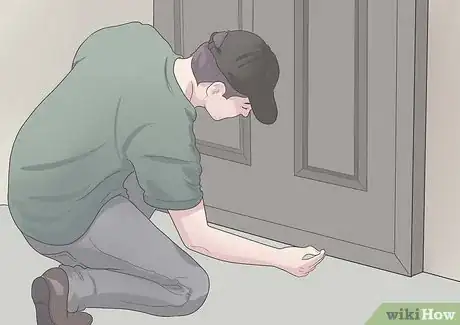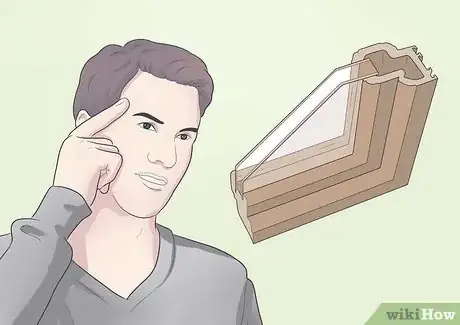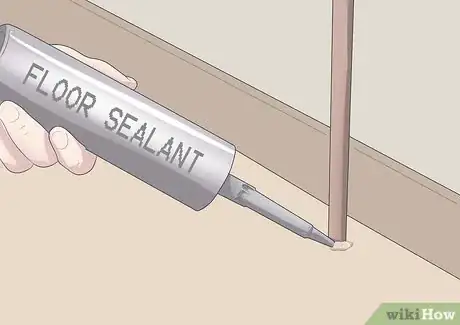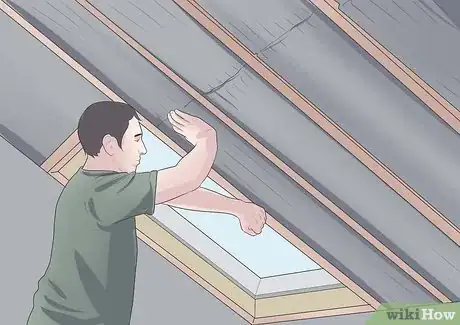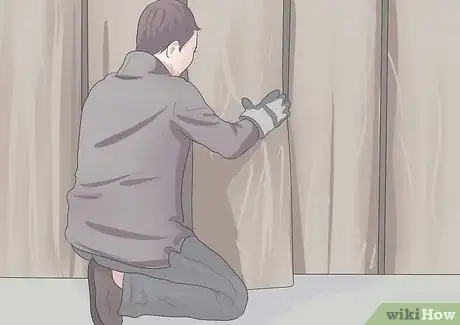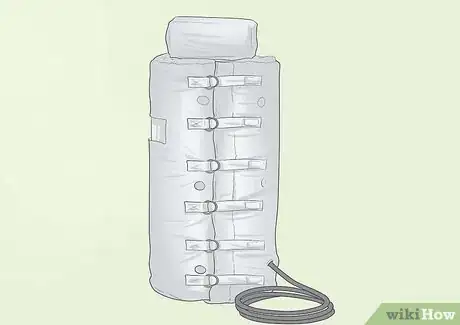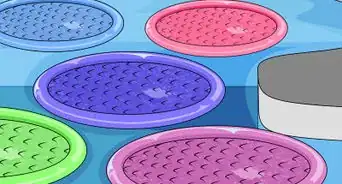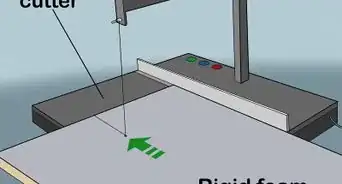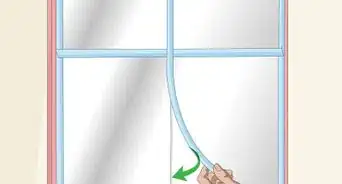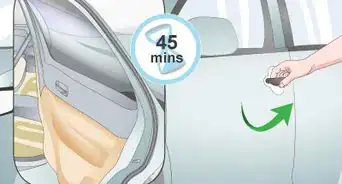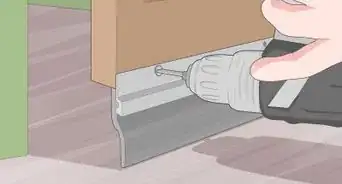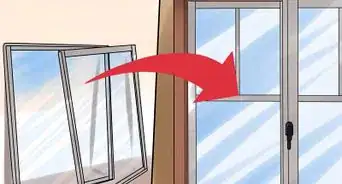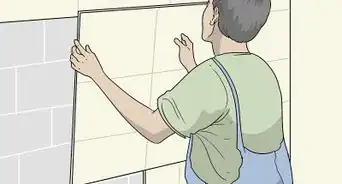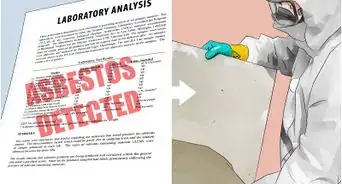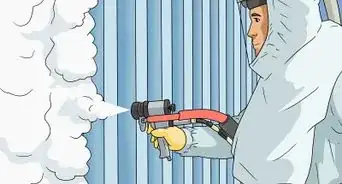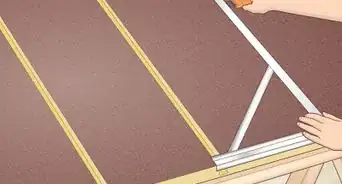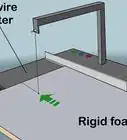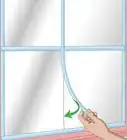This article was co-authored by Kevin Turner and by wikiHow staff writer, Hunter Rising. Kevin Turner is a handyman and the owner of Red Gator Maintenance, a handyman business based in Fresno, California. Working on handyman-related projects since the age of 12, Kevin specializes in a wide variety of home improvement projects such as (but not limited to) lighting/electrical, plumbing, deck staining, drywall repairs, cabinet installation, air conditioning, trash removal, and window, roof, and appliance repairs.
There are 10 references cited in this article, which can be found at the bottom of the page.
This article has been viewed 239,143 times.
Around half of all your heat can escape if your home is not properly insulated. Instead of turning up the thermostat, get insulated! This guide will show you how to insulate your home, saving you hundreds on your energy bills, as well as making a massive reduction to your carbon footprint.
Steps
-
1Stop energy loss via the doors. Fit draught excluders around all exterior doors, and interior if needs be.[1] Sealant strips can be bought cheaply from DIY stores and are very easy to fit - just like applying sticky tape. Don't forget to get a brush trim for letter boxes, bigger gaps and the bottom of doors.[2]
-
2Ensure the windows are well insulated.[3] Cracks and crevices around window frames are a popular escape point for warm air. To check for weak points in your window, run the palm of your hand around the edge of the frame. If you feel a breeze, you've got a hole. Patch the weak points up with a putty or sealer.
- To make it really easy on yourself get the type that comes in a tube. Squirt it on, smooth it over, job done.
Advertisement -
3
-
4Use window dressings to assist. Closing curtains or blinds after dark also traps in the warm air and prevents draughts. And it looks cozy too! Use curtains and blinds with thermal backing for added warmth retention.
-
5Fill any floor gaps.[8] Most homes have gaps between the skirting board and the floor, and if your have floorboards there's likely to be a few gaps between them too. This is a job for the silicone sealer. If you have a wood floor and want to insulate thoroughly, you could get the experts in to fit floor insulation beneath the boards. Putting a rug down isn't a bad idea either.
-
6Insulate the loft or attic.[9] Laying loft insulation on the average home can save a whopping 1 tonne of carbon dioxide a year, and make a major dent in you bills. This is one of the most efficient energy savings options, it is cheap and simple, any person with no experience can do this. It is just to get fiberglass wool and cover all places under your ruff you have access to, fill all gaps in your home around your rooms with it; it costs some 5 Euro or US$6.80 per meter square for 15 centimeter (5.9 in) thick Glass wool. Glass wool is made of mixture of natural sand and recycled glass at 1,450 °C (2642 °F), the glass that is produced is converted into fibers. Glass wool is recyclable material.
-
7Build drywall over "cold wall".[10] If you have some "cold wall" in your home , usually concrete wall with no or with bad insulation you can build 10–15 centimeter (3.9–5.9 in) thick dry wall to it. Process is very simple , you can choose between Ytong wall or plasterboard wall. Plasterboard wall is very simple to build and you can add very good and very cheap Glass wool into it. Glass wool is excellent insulator but you can get glass wool for soundproofing. Both kind of walls are Fire-resistant.
-
8Wrap your hot water tank in a cosy 80 mm jacket.[11] This will cut heat loss by 75 %, and you'll recoup the cost of it in less than 6 months.
Expert Q&A
Did you know you can get premium answers for this article?
Unlock premium answers by supporting wikiHow
-
QuestionHow can I insulate my home cheaply?
 Lui ColmenaresLui Colmenares is a handyman and licensed home improvement contractor for Mr. Handy NYC based in New York City, New York. Lui is trained and educated as an industrial engineer and specializes in carpentry, painting, and general handyman work such as mounting TVs, doorknob and deadbolt installation, furniture assembly, tile repair, and grouting. Mr. Handy NYC prides itself on quality work performed with speed, skill, and punctuality.
Lui ColmenaresLui Colmenares is a handyman and licensed home improvement contractor for Mr. Handy NYC based in New York City, New York. Lui is trained and educated as an industrial engineer and specializes in carpentry, painting, and general handyman work such as mounting TVs, doorknob and deadbolt installation, furniture assembly, tile repair, and grouting. Mr. Handy NYC prides itself on quality work performed with speed, skill, and punctuality.
Handyman
-
QuestionHow much does it cost to insulate your house?
 wikiHow Staff EditorThis answer was written by one of our trained team of researchers who validated it for accuracy and comprehensiveness.
wikiHow Staff EditorThis answer was written by one of our trained team of researchers who validated it for accuracy and comprehensiveness.
Staff Answer wikiHow Staff EditorStaff AnswerIt depends on the type of insulation and whether you do it by yourself or call in a pro. For instance, a DIY blow-in insulation job might cost you about $500, while getting a professional to do the same job could cost you around $2,000. Adding a reflective barrier to your attic, on the other hand, might run around $300 (if you do it yourself) or $700 (if a pro does it).
wikiHow Staff EditorStaff AnswerIt depends on the type of insulation and whether you do it by yourself or call in a pro. For instance, a DIY blow-in insulation job might cost you about $500, while getting a professional to do the same job could cost you around $2,000. Adding a reflective barrier to your attic, on the other hand, might run around $300 (if you do it yourself) or $700 (if a pro does it). -
QuestionCan you insulate your house yourself?
 wikiHow Staff EditorThis answer was written by one of our trained team of researchers who validated it for accuracy and comprehensiveness.
wikiHow Staff EditorThis answer was written by one of our trained team of researchers who validated it for accuracy and comprehensiveness.
Staff Answer wikiHow Staff EditorStaff AnswerSome types of insulation are easier to DIY than others. For example, you can easily lay down insulation material on the floor in your attic. You can also add batting to the walls in your basement or crawlspace. You might need to call in a pro if you want to insulate exterior wall cavities, since this involves cutting through the walls with special tools.
wikiHow Staff EditorStaff AnswerSome types of insulation are easier to DIY than others. For example, you can easily lay down insulation material on the floor in your attic. You can also add batting to the walls in your basement or crawlspace. You might need to call in a pro if you want to insulate exterior wall cavities, since this involves cutting through the walls with special tools.
Things You'll Need
- Insulation
- Sealant
- Double glazing
- Rug
References
- ↑ Lui Colmenares. Handyman. Expert Interview. 18 August 2020.
- ↑ https://www.simplemost.com/diy-draft-proof-doors-windows-home/
- ↑ https://www.bobvila.com/articles/how-to-insulate-windows/
- ↑ https://www.energywise.govt.nz/at-home/windows/double-glazing/
- ↑ Kevin Turner. Commercial Handyman. Expert Interview. 15 July 2020.
- ↑ Kevin Turner. Commercial Handyman. Expert Interview. 15 July 2020.
- ↑ Kevin Turner. Commercial Handyman. Expert Interview. 15 July 2020.
- ↑ https://www.thisoldhouse.com/how-to/how-to-fill-gaps-wide-plank-wood-floor
- ↑ https://www.thisoldhouse.com/ideas/read-you-insulate-your-attic
